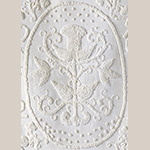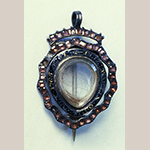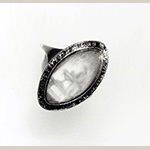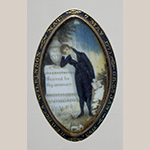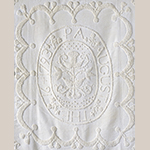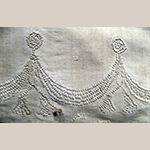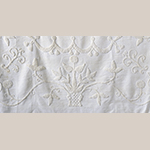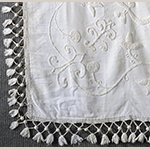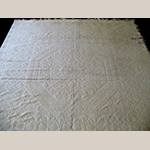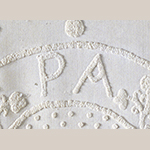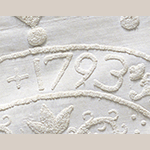In 1980 MESDA acquired a white embroidered bedcover inscribed “PA August the 16+ 1793,” which had descended in the Wright and Warren families of eastern North Carolina (Figure 1). Recognizing the importance of an eighteenth-century bedcover, museum curators conducted preliminary research, resulting in an attribution of the counterpane to Priscilla Armistead of Edenton, North Carolina.[1] However, Priscilla was only ten years old in 1793, which seemed too young compared with the ages of other known counterpane makers.[2] In 2010 a search of online resources located the transcription of the will of Priscilla’s brother William Armistead, who referred to their sister Mary by her nickname “Polly,” who was born five years earlier than Priscilla.[3] Further, the counterpane was donated by the family of Polly’s descendants, not Priscilla’s.
A deeper examination of the counterpane itself reveals much more than the identity of its maker. Polly’s decision to prominently embroider her initials and the date within the central cartouche may reflect feelings of loss and grief. She would soon marry, taking her husband’s name and in the process losing her identity. In the years leading up to the completion of the counterpane Polly grieved multiple deaths in her family. In this sense, Polly may have considered the bedcover to be a material reminder of her individuality as well as an awareness of her mortality.
— ♦♦◊♦♦ —
Polly Armistead’s paternal ancestors were among the early English immigrants to Gloucester, Virginia and their numerous descendants intermarried with other prominent Virginia families.[4] Her father William Armistead was the second son, born in 1730 in Warwick County. As adults, William and his half-brother Anthony Armistead relocated to Bertie County, North Carolina.[5] The Roanoke River forms the county’s southern border creating a navigable channel winding through swampland as it approaches the western edge of the Albemarle Sound. The population of region consisted largely of transplanted Virginians who farmed the fertile high ground.[6] William Armistead acquired land on the Cashie Neck, the area lying between the Cashie and Roanoke rivers.[7] In 1756, William Armistead married Sarah Jordan, the eldest daughter of Joseph Jordan; two years later, his brother Anthony married Mildred Jordan, Sarah’s cousin.[8]
The Jordans were among the earliest settlers of Bertie County, related by marriage to the area’s other prominent families.[9] In 1738 Sarah’s father Joseph Jordan had purchased a three-hundred-acre tract from William Charlton, including a partially completed story-and-a half brick house, built on a three-room plan, with arched windows and T-shaped chimneys at each end (Figure 2).[10] Such houses were typical of those built by the local gentry in the second quarter of the eighteenth century.[11] Although William Armistead was a relative newcomer, his connection with the Jordan family gave him entrée to the gentry in this geographically dispersed community.[12]
William Armistead established himself as a merchant, transporting goods to and from Norfolk on his own ships, among them a brig “Priscilla,” and a schooner “Ostrich.”[13] The Armisteads also operated fisheries on and around the Roanoke River.[14] Enslaved labor was integral to all of the family’s commercial and domestic pursuits, and by 1790 William’s household included five white males, eight white females, and thirty-three enslaved individuals.[15]
Polly was the eighth of eleven children born to William and Sarah Armistead between 1757 and 1783. As daughters of gentry, Polly and her sisters would have received an education appropriate to their station. Their mother may have taught them at home, or they may have attended a school operated by a female instructor offering classes in a combination of academic subjects and needlework to a small number of day and/or boarding students. For example, in 1788 teacher Sarah Moffit advertised her curriculum that specified a wide variety of needlework genres, including:
plain work, marking, sprigging of muslin, linen or sattin. Also the true Dresden and catgut, either coarse or fine, in a direct imitation of lace; shading with silk or worsted; fire and windscreens, table covers, chair bottoms, pocket books and samplers.[16]
Polly Armistead embroidered her counterpane shortly before her sixteenth birthday. Two years later, in 1795, she married David Wright, from Nansemond, Virginia. Americans today often associate white bedcovers with weddings, assuming that young women like Polly must have made their counterpanes “in preparation for marriage.” However, embroidered and quilted bedcovers, including white ones, have a long history as consumer goods in Europe.
Embellished white bedcovers first appeared in French inventories of members of the royal house of Anjou in the early fourteenth century.[17] By the sixteenth century, a commercial cottage industry developed in Provence, exporting quilted and corded bedcovers, petticoats, and yardage throughout Europe and beyond.[18] These luxury textiles inspired the production of less expensive woven white linen and cotton bedcovers in the north of England. Such textiles frequently appeared among the goods enumerated in merchant advertisements and household inventories in colonial America.[19]
American women created embellished white quilts and embroidered counterpanes in large numbers in the closing decades of the eighteenth century, in great variety and often with exuberant stitching.[20] This body of needlework represents a traditional practice that cannot be adequately explained as a continuation of European needlework traditions.[21] Instead, a number of influences and circumstances appear to have coalesced to inspire these material documents of the expressive culture of American women.[22] If we suspend the notion that Polly made her counterpane in anticipation of marriage and take a closer look at the counterpane itself, her motivations for its creation might be revealed.
Polly worked her design using a soft, thick yarn in a technique that in the late eighteenth century was called “knotting” or “tufting” but a century later became known as “candlewick” embroidery.[23] The origin of this type of raised embroidery is unclear.[24] We know that the technique emerged in America sometime in the late eighteenth century and spread rapidly, producing various regional and individual mutations. Polly’s counterpane is almost certainly not the earliest example of this tufted technique, but it is significant as the earliest known, date-inscribed example.[25]
The bedcover’s design is embroidered on a fabric ground of white twill-woven cotton, which was probably among the cotton textiles called “Manchester goods” exported through the bustling port of Liverpool to eager American consumers. The widespread adoption of the cotton gin after 1792 spurred the rapid expansion of cotton production, but the bulk of American cotton production was already transported to Britain and returned as finished goods. The source of the yarn, however, is less certain. Polly had access to imported cotton yarn, grown in the American South and spun in Lancashire. However, although tobacco, wheat, and corn formed the principal crops on Bertie County’s farms and plantations, some cotton was grown by households for personal use. Thus, families in Bertie County possessed a mix of imported textiles and those of local manufacture.
In 1791, the contents of the Armistead household, recorded after the death of Polly’s father William, included the following textile-related items:
8 bedsteads
11 beds
4 suits bed curtains and trimmings
16 window ditto
46 sheets
9 bolsters
10 pillows
17 bedcovers
36 blankets
1 carpet
1 quilting frame, warping bars & loom
Slays & harnesses
4 [spinning] wheels with cards
1 clock reel
1 flax hackle[26]
The suits of coordinating bed and window curtains would have been ordered from upholsterers located in London, Norfolk, or some other fashionable center. The blankets could have come from English woolen mills, local professional weavers, or home production. The inventory does not indicate the location of the loom and related tools, so it is not clear if these items were used by the Armistead women, by their enslaved servants, or both. The presence of a quilting frame, however, suggests that Polly most likely used it to stretch the twill ground fabric to maintain tension for her embroidery.
Polly would have stitched the yarn onto the stretched ground of her counterpane using a blunt-pointed, large-eyed needle. She sewed rows of loops then cut the yarn between the stitches to create tufts. Only the isolated knots and the loops forming the small recurring tendrils were left uncut. Her tufted designs utilized only a few of the many stitches in the traditional embroiderer’s skill set; however, Polly did not take shortcuts. For example, in working a pattern of knots above and below the central image, she left each knot separate. Instead of leaving a “traveling” yarn connecting the series of dots from one to another on the back side, she carefully trimmed or turned in the ends of the yarn so that the back is as neat as the front, a traditional standard of excellence among embroiderers (Figure 3).[27]
The central figure of an oblong cartouche encloses a compact, symmetrical figure featuring a large daffodil-like blossom atop a stem that descends to a suggestion of curled roots. Additional tri-lobed blossoms, leaves, and curlicues attach to the stem, and a loose scatter of knots fills the space above and below. The design bears resemblance to those used in eighteenth-century crewel embroidery.[28] The wide rim of the cartouche provides a narrow band for the inscription and smaller flowers. The central figure is formal, regular, and contained (Figure 4).
Polly’s choice of a cartouche for the center of her counterpane is unusual. In the late-eighteenth and early nineteenth centuries, large floral baskets, cornucopias, or eagles garnered the central spotlight in the majority of counterpanes and quilts. Given the likelihood that she would have seen other decorative bedcovers with large, flowing designs, why might Polly have centered her counterpane with such a relatively small, constrained design element? The creation of a quilt or counterpane has been described as “an organic process, closely related to the deepest feelings one has about life and the society in which one lives, and those individuals with whom one is most intimate.”[29] Polly’s feelings, her sense of self within her family, and her state of mind likely contributed to her design choices.
The inscribed rim of the cartouche is similar to designs found on official or governmental images such as signet rings, stamps, and coins; however, the oval form suggests a connection with examples of mourning jewelry of the late eighteenth century.[30] The tradition of distributing rings inscribed with the name of the deceased to family and close friends accompanied European immigrants to the American colonies.[31] By the late eighteenth century, the genre expanded to include lockets, pendants, and brooches.[32]
The oval cartouche on Polly’s counterpane, encircled with an inscribed band, distinctly relates visually to examples of mourning jewelry. Mourning jewelry from the 1760s often displayed hair of the deceased under a glass oval, framed with a gold bezel inscribed with a name and date of death (Figure 5). The bezel of a 1779 oval ring honors the memory of a Lancaster, County, Virginia woman, “Eliza Chinn OB 11 March 1779”; the glass crystal covers the figure of a male mourner standing beside an urn mounted on a pediment under a cascade of willow branches (Figure 6). Another brooch featuring a similar image, memorializes Rebecca Wilkinson, who died in Southampton County, Virginia in 1793, two counties away and the same year that Polly finished her counterpane (Figure 7).[33]
Polly was almost certainly familiar with similar mourning jewelry as her family experienced death repeatedly in the years leading up to 1793. Her brother Anthony died in 1789 at age twenty-five, followed by the death of her father William Armistead, age sixty-one, in 1791. Later the same year, the death of William’s childless brother Anthony left Polly, her mother, and her siblings the only remaining Armisteads in the area.[34]
The Jordan family also suffered losses, most significantly Polly’s maternal grandparents, Joseph and Ruth Speight Jordan, who both died in 1776 or 1777, and Sarah Jordan would have been in mourning at the time of Polly’s birth in September 1777. Given the mourning customs of the time, Polly may well have remembered a mourning brooch that her mother wore. Sarah’s brother Joseph Jordan died in 1785, and her two remaining brothers Isaac and William both died in 1790.
By 1791 Sarah Jordan Armistead was not only the newly widowed head of her own household, but the eldest of the three surviving Jordan sisters.[35] Sarah appears to have dealt successfully with her new responsibilities, but the settlement of multiple estates and family affairs would have required much of her attention.[36] Polly’s two older sisters, Elizabeth and Sarah, married during this time—her older brothers were already adults—leaving Polly at home to care for her two younger siblings, brother Starkey and sister Priscilla.[37]
In light of the multiple deaths in her family, the tight oval of Polly’s counterpane might reflect her grief. Many generations of women turned to the physical practice of needlework for solitude and solace in times of sorrow.[38] Girls of Polly’s age in this society were making the transition from childhood to their adult roles. Gender historian Martha Tomhave Blauvelt writes that during this period:
maturing girls commonly found that previous emotional patterns and expectations…shifted: as they grew up, their culture demanded not just surface acting—disguising anger, displaying genteel manners, or saying the expected—but the deep acting of submissive mothers, wives, and church members who had internalized their culture’s values.”[39]
Polly seems to have negotiated this emotional ground by the practice of her embroidery. She adapted a recognized symbol of mourning in the center of her counterpane. The central cartouche may embody Polly’s emotional state. It both protected and restrained by her social identity. The oval also suggests a seed, dormant but containing the promise of an inner blossom.
Moving outward, the cartouche is surrounded by an inner border of a swag and tassel motif, variations of which are widely distributed across the decorative landscape, in wallpaper, textiles, interior trim, and case furniture. Polly’s version presents a somewhat rigid, rectangular frame, slightly softened into an octagon to conform more closely to the ovoid within (Figure 8). From the back side, we see that Polly created her full-blown tufted swags and tassels by stitching rows and spirals of relaxed loops, creating tiny tufts by clipping the loops on the top of the counterpane (Figure 9). The resulting fullness of her swags is not as delicate and graceful as that seen in other period embroidery, suggesting that Polly was still learning to organize and space her tufted motifs. Though somewhat awkward, the swing and droop of her swags and tassels trace a definite movement away from the rigid constraint of the center.
By the time Polly reached the outer border, her design opened up considerably. Four repeats of a basket incorporate long, curved vines adorned with various leaves and flowers, similar to those that grace the center of other counterpanes and quilts. A tufted pompom takes center stage, uplifted by angelic leaf-wings. Moving outward, the flowing curve of the outreaching vines fills the horizontal spaces, lightly punctuated by tufted blossoms and untufted tendrils (Figure 10). The long flowing stems echo the unbroken, undulating grapevines that delineate the borders of other counterpanes, and Polly closed the corner gaps with the addition of curlicues that suggest a freer version of the tendrils seen in the cartouche (Figure 11).[40]
Finally, no counterpane of the period was complete without the application of a decorative fringe. Although some women crafted fringes themselves, Polly used a ready-made fringe, probably imported from England and available in her father’s store.
Presumably 16 August 1793 is the date that Polly completed her counterpane. Some women even included the word “finished” or “done” with such a specific day and month. This indicates that Polly planned for the inscription from the beginning, leaving the rim of the cartouche blank until the rest was done. That Polly worked her initials into the rim of the cartouche might have been because she was deeply affected by the deaths in her family, causing her to recognize her mortality and wishing to materially create some form of permanence to preserve her identity.
The counterpane tells us that Polly expressed the loosening stages of her grief by the choice and arrangement of various design elements. She accomplished this, not through the traditional medium of surface embroidery, but in a newer, simpler, and more exuberant mixture of knots and tufts. Other women of her generation made refined counterpanes, using fine yarn and intricate stitches as they had learned in school. But their teachers would not have approved the emerging practice of tufted embroidery, which meant that a counterpane like Polly’s could be worked in a matter of weeks rather than months.[41]
Not all counterpanes of the period were stitched by hand. The word “counterpane” is an ambiguous term, which by the fifteenth century referred specifically to an embellished decorative bedcover, typically white. While retaining this meaning, popular usage of the term broadened by the late eighteenth century to include other forms and colors of decorative bedcovers. During the late eighteenth and early nineteenth centuries, handwoven white cotton counterpanes were imported from Bolton, Lancashire in great quantities. The complex raised designs of these Bolton counterpanes found favor in the homes of wealthy Americans and survive in many museum collections (Figure 12).[42]
During the same period, professional weavers in Norfolk and Baltimore also produced and advertised counterpanes. In 1775, Norfolk weaver Gardiner Fleming advertised, “COTTON, Flax, or woolen yarn wove at the most reasonable rates, of any fineness, figure, or width, such as…counterpanes…of any pattern or width.”[43] Counterpanes listed in probate records might refer to any of these textiles. The 1806 inventory of the estate of John Shepherd Ker of Onancock, Virginia lists two “English knotted” counterpanes, which clearly refer to Bolton woven imports, in addition to a total of ten “white counterpanes,” which could be imported or domestic. The 1813 will of Mary Willing Byrd includes a rare, very specific bequest to her daughter of “the red damask bed and the bedstead belonging to it with the handsomest Virginia cloth counterpoint [k]not worked [emphasis by author] and blankets and also the red and white chair covers.”[44]
After their 1795 marriage, Polly lived with her husband David Wright in Norfolk, where they had six children. David Wright died in 1813, at age thirty-eight, and it seems likely that Polly returned with her children, ages four to sixteen, to North Carolina, probably to her mother’s home. Polly died in 1817 at age forty and was buried with her husband in St. Paul’s Episcopal Church cemetery in Edenton.[45] Her mother, Sarah Jordan Armistead, died a year later. Polly’s four oldest children, boys aged fourteen to twenty-one, would likely have found work with the assistance of Polly’s only surviving brother, Starkey. Her sister Priscilla’s husband Joel Thorpe became the guardian of Polly’s daughter Sarah (“Sally”) Jordan Wright, age ten, and, presumably, also her youngest son David Minton Wright, age eight.[46] David Minton Wright grew up to become a doctor. He practiced medicine in Norfolk. In 1863, during the occupation of Norfolk by Union troops, he was hanged for shooting an officer who attacked him for expressing his indignation.[47]
At the time of his death, David Minton Wright and his wife Penelope Creecy Wright were the parents of eight surviving children, aged seven to twenty-three. Daughter Sarah “Sallie” Jordan, born in 1850, became the second wife of Thomas Davis Warren about 1871. The seventh of their eight children was David Minton Warren (1890–1944), whose only child was David Minton Warren Jr. (born 1916–1966). In 1980, the counterpane was brought to MESDA by his widow, Rebecca Warren.
Nobody in the family remembered the identity of “PA” stitched onto the counterpane. They remembered the story of the martyrdom of David Minton Wright, retold to his namesake in each generation. They knew that the counterpane was a family heirloom, connected in some way to their ancestral history. It is likely that, had her son died in less dramatic circumstances, Polly’s counterpane might not have retained the associations that prompted descendants to preserve it as a tangible piece of family history.
— ♦♦◊♦♦ —
Not all women of Polly’s time created embellished white quilts or counterpanes. Those who did rarely made more than one. Some women stitched in their names or initials, sometimes a date; others did not. Some families handed down their ancestral counterpanes along with the name of the maker. In others, the maker was unknown. Sometimes, as in this case, the connection can be re-established, and the maker’s identity restored to her work.
The women who made the counterpanes expressed their individuality in the originality of the design, the proficiency of the stitches, and the fact of its material existence. Women recognized this code, but men would not have done so. While a husband might take pride in his wife’s accomplishment, he would not likely recognize her counterpane as an embodiment of her individual identity. These counterpanes rarely appear in women’s wills or estate inventories. Mary Willing Byrd’s 1813 will was an exception. If such a counterpane was inadvertently enumerated in a man’s estate, his widow or daughters might have to purchase it back at auction.[48] Instead, women generally handed down items of personal significance as part of an undocumented, non-monetary female economy.[49]
When Polly Armistead embroidered her initials and the date in the center of her counterpane (Figures 13 and 14), she understood that she would probably marry, lose her name, and take on a new identity as wife and mother. Through the rest of her life, she may have regarded her counterpane as a touchstone, a material reminder of her individuality and an awareness of her own mortality.
A search for Polly Armistead—or Mary Wright— in public records and online sources provides only a few scattered references in relation to various family members. While the name of her mother Sarah Jordan was bestowed upon numerous female descendants, Polly inspired no known namesakes. Her white cotton counterpane appears to be the sole surviving material document of her life.[50]
Laurel Horton is an independent textile scholar who has written and presented extensively about early American bedcoverings and needlework. She can be reached at [email protected].
[1] Collections record for MESDA Acc. 3173, Winston-Salem, NC; Paula W. Locklair, Quilts, Coverlets and Counterpanes from the Museum of Early Southern Decorative Arts and Old Salem Collections (Winston-Salem, NC: Old Salem, 1997), 27.
[2] Of forty-three identified makers of “candlewick” counterpanes whose ages are known, twenty-four were made by women in their twenties. Gail Bakkom, “What Makes it ‘Candlewicking?’ ” American Quilt Study Group Seminar, 3 October 2012, Lincoln, NE.
[3] Will of William Armistead Jr., dated 7 July 1793, probated August 1796, North Carolina Probate Records, 1735–1970, Bertie County, Wills, 1784–1797, Vol. D, p. 339; available online: https://www.familysearch.org/ark:/61903/3:1:939L-VW35-76?i=361&wc=32LK-3TL%3A169765101%2C169908101&cc=1867501 (accessed 25 January 2019).
[4] Virginia Armistead Garber, The Armistead Family, 1635–1910 (Richmond, VA: Whittet & Shepperson, 1910), 245–247; available online: https://archive.org/details/armisteadfamily100garb/page/n5 (accessed 29 January 2019).
[5] Sally Moore Koestler, “William Armistead & Sarah Jordan,” Sally’s Family Place, online: https://sallysfamilyplace.com/william-armistead-sarah-jordan/ (accessed 29 January 2019).
[6] Alan D. Watson, Bertie County: A Brief History (Raleigh, NC: Division of Archives and History, NC Department of Cultural Resources, 1982), 1–2.
[7] William and Anthony also purchased land in adjoining Northampton County between 1753 and 1757. Garber, 218.
[8] Sally Moore Koestler, “William Jordan, Mildred & Mary Ann Hill,” Sally’s Family Place, online: https://sallysfamilyplace.com/william-jordan-mildred-mary-ann-hill/ (accessed 29 January 2019).
[9] Thomas R. J. Newbern and James R. Melchor, WH Cabinetmaker: A Southern Mystery Solved (n.p.: Legacy Ink, 2009), 69.
[10] Bertie County Deed Book E, p. 319, cited from Koestler, “William Armistead & Sarah Jordan.” See also Charlton-Jordan House, Rare and Unique Digital Collections, North Carolina State Libraries, online: http://d.lib.ncsu.edu/collections/catalog/buch0010 (accessed 29 January 2019).
[11] Catherine Bishir, North Carolina Architecture (Chapel Hill: University of North Carolina, 1990), 12–13; Catherine Bishir and Michael Southern, A Guide to the Historical Architecture of Eastern North Carolina (Chapel Hill: University of North Carolina, 1996), 281–282; Mills Lane, Architecture of the Old South: North Carolina (Savannah, GA: Beehive, 1985), 20.
[12] Newborn and Melchor, 25.
[13] Inventory of William Armistead Sr., North Carolina Estate Files, 1663–1979, Bertie County, A, Armistead, William, images 101–108; online: https://www.familysearch.org/ark:/61903/3:1:33S7-9PT3-SMVS?i=100&wc=Q6W5-38D%3A183208201%2C183204102%2C183331001&cc=1911121 (accessed 25 January 2019).
[14] Will of William Armistead Jr. and Will of Sarah Jordan Armistead, North Carolina Probate Records, 1735–1970, Bertie County, Wills, 1784–1797, Vol. G, p. 42–43; available online: https://www.familysearch.org/ark:/61903/3:1:939L-JCNT-P?i=66&wc=32LF-168%3A169765101%2C169978901&cc=1867501 (accessed 29 January 2019).
[15] 1790 United States Federal Census, Bertie Co., NC.
[16] Norfolk and Portsmouth Journal (Norfolk, VA), 23 July 1788, 3-3.
[17] Kathryn Berenson, “Quilted Works ‘of Naples’: The French and Italian Context of the Tristan Quilts,” Quilt Studies: The Journal of the British Quilt Study Group, edited by Hazel Mills, Issue 13 (2012): 7–37.
[18] Kathryn Berenson, Marseille: The Cradle of White Corded Quilting (Lincoln: University of Nebraska, 2010).
[19] Sally Garoutte, “Early Quilts in a Bedding Context” in Uncoverings 1980, edited by Sally Garoutte (Mill Valley CA: American Quilt Study Group, 1981), 115–134.
[20] Period bedcovers are generally categorized as either counterpanes (a single layer of fabric with decorative stitching) or quilts (two or more layers stitched together, often with batting stuffed between them).
[21] Two published articles represent the author’s early, unsuccessful search for European antecedents: “Early Quiltmaking among the Ulster-Scots in the Southern United States,” Quilt Studies 8, edited by Dorothy Osler (2007): 65–82 and “Two Early-Nineteenth-Century Bedcovers with Salem, North Carolina, Connections, in Journal of Early Southern Decorative Arts, edited by Gary Albert, Vol. 31, No. 11 (Winter 2005–Winter 2006): 149–168; available online: https://archive.org/details/journalofearlyso301321muse (accessed 29 January 2019).
[22] Laurel Horton, “Early American White Bedcovers: The Invention of Necessity,” video from The Global Quilt Symposium, 2 April 2011, International Quilt Study Center, Lincoln NE, online: https://www.youtube.com/watch?v=GNkjIs4NPwA&feature=youtu.be (accessed 29 January 2019).
[23] Bakkom, “What Makes it ‘Candlewicking?’ ”
[24] Tufting and the use of a soft, thick cotton yarn are not found in publications on needlework in Great Britain in the eighteenth century. Gail Marsh, 18th Century Embroidery Techniques (Lewes, East Sussex, UK: Guild of Master Craftsman Publications, 2006).
[25] A number of surface embroidered counterpanes survive from the eighteenth century, and a New England “candlewick” counterpane worked with loop stitches, rather than tufts, was made by Abigail Leverett, inscribed 1792 (Historic Deerfield Collection, Acc. F.731); Bakkom, “What Makes it ‘Candlewicking?’ ”
[26] Inventory of William Armistead Sr., images 107–108.
[27] An internet search using “embroidery” and “back is as neat as the front” revealed both historical and contemporary usages.
[28] Judith Reiter Weissman and Wendy Lavitt, Labors of Love: American’s Textiles and Needlework, 1650–1930 (New York: Alfred A Knopf, 1987), 113; Amelia Peck, American Quilts and Coverlets in the Metropolitan Museum of Art (New York: MQ Publications USA, 2007), 196–201.
[29] Lucille Hilty, “A Passion for Quiltmaking,” in Uncoverings 1980, edited by Sally Garoutte (Mill Valley CA: American Quilt Study Group, 1981), 17.
[30] Thanks to Laura Beth Simo for pointing out this similarity.
[31] Martha Gandy Fales, Jewelry in America, 1600–1900 (Woodbridge, Suffolk, UK: Antique Collectors’ Club, 1995), 23–25.
[32] Fales, 27–28; Sarah Virginia Bent, “ ‘In Memory of Margaret Ridley Long Tyler’: A Comparative Study of Mourning Miniatures,” p. 5, final paper, 1991 MESDA Summer Institute, Winston-Salem, NC.
[33] These examples featuring the archetypal image of mourner, urn, pediment, and tree predate the 1799 death of George Washington, frequently cited as the impetus for the general popularity of this emblem of American mourning art. Anita Schorsch, Mourning Becomes America: Mourning Art in the New Nation (Harrisburg, PA: William Penn Memorial Museum, 1976).
[34] Koestler, “William Armistead & Sarah Jordan.”
[35] Ibid.
[36] The settlement of family estates typically involved calculating percentages of the earnings and expenses of slaves and other property divided among survivors, further complicated and subdivided by the subsequent deaths and bequeathals of those heirs. For example, the estate of William Armistead Sr. could not be settled until the death of his wife twenty-seven years later, during which time several of his other heirs died, bequeathing their shares to siblings or children.
[37] Koestler, “William Armistead & Sarah Jordan.”
[38] Carolyn H. Krone and Thomas M. Horner, “Quilting and Bereavement: Her Grief in the Quilt,” in Uncoverings 1992, edited by Laurel Horton (San Francisco, CA: American Quilt Study Group, 1993), 109–126.
[39] Martha Tomhave Blauvelt, The Work of the Heart: Young Women and Emotion, 1700–1830 (Charlottesville: University of Virginia, 2007), 147.
[40] These motifs bear a noticeable similarity to embellished furniture made in Bertie County. See Newbern and Melchor.
[41] For a discussion of a later tufted counterpane, see Laurel Horton, “The Making of a Kentucky Counterpane,” Journal of Backcountry Studies, Vol. 8, No. 1 (2013), online: http://libjournal.uncg.edu/jbc/issue/view/77 (accessed 29 January 2019).
[42] Erin Beeston and Laurel Horton, “Bolton’s Cotton Counterpanes: Hand-weaving in the Industrial Age,” in Quilt Studies 14, edited by Hazel Mills (York, UK: British Quilt Study Group, 2013), 7–36; Laurel Horton, “Weft-Loop Woven Counterpanes in the New Republic: The Re-discovery of a Textile Legacy,” Uncoverings 2014 (n.p.: American Quilt Study Group, 2014).
[43] The Virginia Gazette or Norfolk Intelligencer (Norfolk, VA), 15 June 1775, 3–3.
[44] Virginia Magazine of History and Biography, Vol. 6, No. 4 (April 1899): 346.
[45] Gravestone of Mary “Polly” Armistead Wright (1777–1817), St. Paul’s Episcopal Churchyard, Edenton, Chowan Co., NC; available online: https://www.findagrave.com/memorial/106783674/mary-wright (accessed 29 January 2019).
[46] Estate settlement file for Sarah Jordan Armistead, North Carolina Estate Files, 1663–1979, Bertie County, A, Armistead, William, images 101–108; online: https://www.familysearch.org/ark:/61903/3:1:33S7-9PT3-SMVS?i=100&wc=Q6W5-38D%3A183208201%2C183204102%2C183331001&cc=1911121 (accessed 25 January 2019).
[47] Garber, 253-256.
[48] For an example of daughters buying their mother’s quilts and counterpanes after the death of a stepmother, see Laurel Horton, Mary Black’s Family Quilts: Memory and Meaning in Everyday Life (Columbia: University of South Carolina Press, 2005), 26.
[49] Ibid, 157–158.
[50] Garber, 249. Interviewed in 1910, Alexander Welborne Weddell owned a miniature of his great-grandmother Mary Armistead Wright. The current location of this portrait remains unknown.
© 2019 Museum of Early Southern Decorative Arts

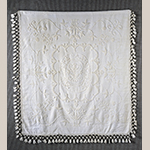
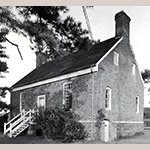
![Fig. 3: Detail of the counterpane (obverse [left] and reverse [right]) illustrated in Fig. 1.](https://www.mesdajournal.org/files/Horton_Fig_03_Thumb.jpg)
